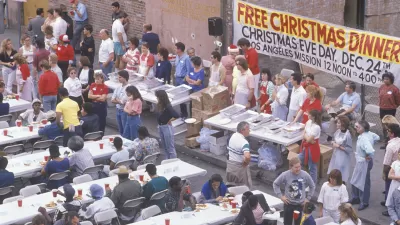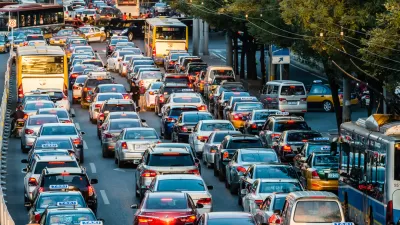A new study shows how pollution and poverty can create a persistent cycle in poor neighborhoods.

Political expedience often pushes undesirable, but necessary, land uses out of rich neighborhoods. These coal stacks, prisons, and highway overpasses are what The Smart Growth Manual calls LULUs, or what Joe Cortright calls “disamenities” in a piece for City Commentary. "Poor neighborhoods tend to bear a disproportionate share of the exposure to environmental disamenities of all kinds," Cortright writes. Worse still, these disamenities tend to create a feedback loop. "If a neighborhood is highly polluted or crime-ridden, people with the economic wherewithal to move elsewhere typically will. When they abandon dirty or dangerous places, the rents fall, and by definition, the residents of these neighborhoods disproportionately become those who lack the resources to afford a better alternative: the poor," Cortright explains.
Sadly, all this is not new news to city watchers. What gives new perspective is a historical study from St. Andrew's University. "The study shows that variations in pollution levels are significant factors in explaining the distribution of poverty within cities in the 19th century," Cortright reports. One interesting insight from the study reveals why the East End was so often the poorer side of industrial cities. The idea investigated here is that in cities powered by coal, if the prevailing winds blew from West to East, that meant that pollution would be blown to the east side of town, causing issues that long outlasted the industrial revolution.
FULL STORY: Pollution and poor neighborhoods: A blast from the past

Alabama: Trump Terminates Settlements for Black Communities Harmed By Raw Sewage
Trump deemed the landmark civil rights agreement “illegal DEI and environmental justice policy.”

Planetizen Federal Action Tracker
A weekly monitor of how Trump’s orders and actions are impacting planners and planning in America.

The 120 Year Old Tiny Home Villages That Sheltered San Francisco’s Earthquake Refugees
More than a century ago, San Francisco mobilized to house thousands of residents displaced by the 1906 earthquake. Could their strategy offer a model for the present?

In Both Crashes and Crime, Public Transportation is Far Safer than Driving
Contrary to popular assumptions, public transportation has far lower crash and crime rates than automobile travel. For safer communities, improve and encourage transit travel.

Report: Zoning Reforms Should Complement Nashville’s Ambitious Transit Plan
Without reform, restrictive zoning codes will limit the impact of the city’s planned transit expansion and could exclude some of the residents who depend on transit the most.

Judge Orders Release of Frozen IRA, IIJA Funding
The decision is a victory for environmental groups who charged that freezing funds for critical infrastructure and disaster response programs caused “real and irreparable harm” to communities.
Urban Design for Planners 1: Software Tools
This six-course series explores essential urban design concepts using open source software and equips planners with the tools they need to participate fully in the urban design process.
Planning for Universal Design
Learn the tools for implementing Universal Design in planning regulations.
Clanton & Associates, Inc.
Jessamine County Fiscal Court
Institute for Housing and Urban Development Studies (IHS)
City of Grandview
Harvard GSD Executive Education
Toledo-Lucas County Plan Commissions
Salt Lake City
NYU Wagner Graduate School of Public Service





























